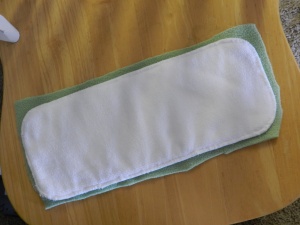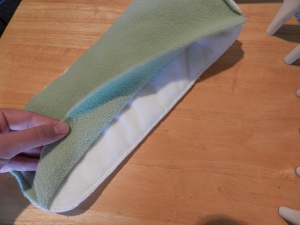*Updated Sept. 1, 2012
Although many cloth diapering newbies (and veterans) choose to use disposable diapers at night, we’re using exclusively cloth. Wash routines are difficult for some families to get down. For me, it was the night-time diapering routine. And whatever works for my baby now won’t work in a year, when he’s bigger and pees in greater concentrations. Big Baby = Big Pee
There are several different common fabrics used for cloth diapers, with bamboo considered one of the most absorbent. Wool is also an extremely popular night-time choice, but more expensive than bamboo. Knowing this, I decided to go with bamboo.
I do wash every other day, so initially I thought two night-time diapers would be enough to switch through, but then Mr. Stinky Pants pooped at 10 p.m. once, so I had to put him in the spare diaper. Now we have two more diapers on the way for a grand total of four. They are: 2 Kiwi Pie One-Size Fitted Diapers, 1 Blueberry One-Size Fitted Diaper, and 1 Bummis Tots Bots Bamboozle Stretch Diaper in Size 2. I’m still waiting for the Tots Bots diaper to arrive, but so far I prefer the Kiwi Pie (see below) over the Blueberry. I’ll explain that one in a different post.
Generally, a diaper should be changed every two hours, whether it’s cloth or disposable. Overnight though, this isn’t always a good plan. Even if you have a child like mine that wakes up every two or three hours, you still don’t want him to wake ALL the way up by changing him that often. I wanted a diaper that he could wear for 4 or 5 hours straight. With a waterproof cover over top, the bamboo diapers we have will hold his pee in overnight, and there’s no leakage in the morning. But we were concerned about my son feeling wet and getting a possible rash from this.
Feeling wet can actually be a benefit of cloth diapering. It’s believed that cloth diapered kids tend to potty train early, because they feel wet and don’t like it. But my son is much too young for potty training, so at this point it’s a hindrance not a benefit.
Many pocket diapers use microfiber inserts. These are great because they absorb well, and they wick moisture away from the baby’s skin. But they can’t go directly against the baby’s skin because of it. They may take away too much moisture and cause skin problems.
We have plenty of microfiber inserts, so I decided to cut up an old fleece blanket and make microfiber-fleece doublers (with the fleece against his skin) to go inside his bamboo diapers. This way, Mr. Stinky Pants will have a very absorbent diaper that also keeps the moisture away from his skin.
When I initially cut the piece of fleece from the blanket, I made it big enough to overlap over the insert. If you’re not planning on sewing the fleece to the microfiber insert (and you don’t have to), you want to make sure your fleece piece completely covers the microfiber insert, so there’s no chance of the microfiber touching baby’s skin. Then you’ll just lay it in your baby’s diaper. The great thing about fleece is that it doesn’t fray, so you don’t need to zig-zag stitch or serge the edge of the cloth.
Since I was planning to sew them together, I pinned the fleece on top the microfiber, and cut around it closely. If you’re using a sewing machine, be careful when you sew the fleece to the insert. The microfiber insert is very thick to sew through. If you’re going to hand sew, I’d recommend just sewing some stitches in each of the four corners…just enough to keep the inserts together. Unless of course, you’re super talented (unlike I) and quick at sewing by hand (also unlike I). Then by all means, sew it all together!
I only sewed the shorter ends together. This will allow faster drying time in the dryer.
Well, there you go…a super quick and super easy stay-dry fix!
Don’t feel like making your own fleece doublers? Buy a pack of five Bummis Reusable Fleece Liners on Amazon for $5.58.
Comments? Questions?
Note: This post contains affiliate links.






